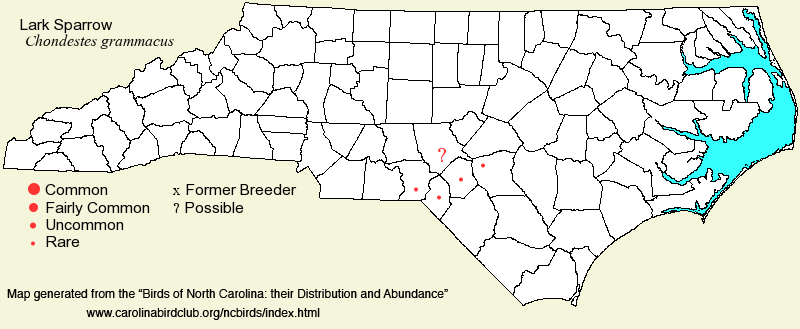 |  |
|
Lark Sparrow - Chondestes grammacus PASSERELLIDAE Members: | Search Common: Search Scientific: |
|
|
|||||||
| General Comments | The Lark Sparrow, as with the Vesper Sparrow, is by itself in a monotypic genus; no other sparrow is remotely like it. It is primarily a Western species, nesting uncommonly and locally into the Midwest, with an outpost in the Sandhills in the Carolinas, far from the rest of the range. Lark Sparrows nest mostly where there are scattered shrubs and small trees, but with some grasses and bare ground, in dry country. Such habitats -- desert scrub, weedy pastures/grasslands -- are abundant in the western half of the country, but in the Sandhills they nest in very specific sites, only in mostly grassy places with scattered saplings, but with some bare sand. In North Carolina, these places are found essentially only at Fort Bragg (now named Fort Liberty, starting in 2023) and Camp Mackall, and there mainly in paratrooper drop zones. At other seasons, Lark Sparrows are found mainly along the coast in fall, with a few remaining into winter. Birds near the coast are normally seen in sandy places with clumps of live oaks and other coastal shrubs; inland birds (mainly in migration) occur in a variety of weedy fields and edges, but usually with some bare ground nearby. The normal winter range is Texas and California south into Mexico. | ||||||
| Breeding Status | Breeder | ||||||
| NC BRC List | Definitive | ||||||
| State Status | SR | ||||||
| U.S. Status | |||||||
| State Rank | S1B | ||||||
| Global Rank | G5 | ||||||
| Coastal Plain | Sparse summer resident, transient, and winter straggler. In summer, rare and local, only in the Sandhills, and essentially at drop zones in Fort Bragg and Camp Mackall; see [Chat 46:1-8 link], [Chat 54:16-20 link]. There have been a few additional summer sites in the Sandhills, and a nest was photographed in the Sandhills Game Land (Scotland) in late May 2017. A few birds also have been seen on the Sandhills Game Land at George Drop Zone in 2023-2025, where almost certainly they are nesting. In fall, rare to locally uncommon along the immediate coast, and essentially casual elsewhere; numbers seem to have declined in recent decades. In winter, rare along the coast, and mainly in early winter, though a few birds do survive the winter; very rare in winter farther inland. A count of 6 individuals along Newland Road in Washington on 5 Dec 2015 was outstanding away from the immediate coast, as was as many as 6 at a feeder/yard along Alder Branch Road (Camden) all winter 2019-20. A few birds wintered at this last locale (Camden) in 2020-21 and at least one did in 2021-22. No northbound migration seen. Mainly late Aug through mid-Oct. One at Alligator River NWR (Dare) on 4 Jun 2018 was unusual near the coast in early summer. Breeding birds arrive in mid- or late Apr. Peak coastal counts: 9, Cape Hatteras, 20 Jan 1938; 7, Pea Island, 4 Sep 2005; inland -- 8, central Hoke, 17 Jun 2023; 7, northern Hoke, 1 Jun 2023; 6, at a feeder in Camden in late fall - winter 2019-20; 6 (apparently three pairs) at Luzon Drop Zone (Scotland), 13 Jun 2020. | ||||||
| Piedmont | Transient. Casual to very rare in spring, and very rare in fall; scattered over the region. Mainly mid-Apr to mid-May, and late Jul to early Oct. A handful of records in winter, and scattered throughout the year (records for each month). There is a record of an apparent nest in Raleigh in 1890 [Chat 47:73-75 link], which is the only indication that the species has ever nested in this province. One photographed in Guilford on 2 Jun 2019 was presumably a very late spring migrant. Peak counts: 5, Pee Dee NWR, 3 Jan 1998. | ||||||
| Mountains | Transient. Casual to very rare in spring (eight records), and very rare in late summer/fall (about 14 records). In spring, the records are from 1 Apr - 15 May, plus a surprisingly early one photographed on 24 Mar 2015; "fall" dates range from 3 Jul to 16 Nov. There is also one winter (30 Dec) report. Peak counts: 1, on many dates. | ||||||
| Finding Tips |
Most breeding sites are generally off-limits to birders on military reservations (especially at Fort Liberty). However, in recent years a few birds have been seen in summer and likely breed at George Drop Zone on the Sandhills Game Land, open to the public. Otherwise, the best places to look are along the coast, in Aug or early Sep. This species is not too shy or difficult to re-find once a report is made in the state; thus, you have a decent chance of seeing one that way. * to ** | ||||||
| Attribution | LeGrand[2025-07-28], LeGrand[2025-02-04], LeGrand[2024-08-06] | ||||||
| NC Map Map depicts all counties with a report (transient or resident) for the species. | Click on county for list of all known species. |
| NC Breeding Season Map Map depicts assumed breeding season abundance for the species. |  |